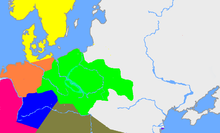Lusatian culture
 Lusatian culture's furthest extent (green) | |
| Alternative names | Lausitz culture |
|---|---|
| Geographical range | Central Europe |
| Period | Late Bronze Age to early Iron Age |
| Dates | c. 1200–500 BC |
| Preceded by | Trzciniec culture, Tumulus culture, Nordic Bronze Age, Urnfield culture |
| Followed by | Pomeranian culture, Cimmerians |
The Lusatian culture existed in the later
Origins



The Lusatian culture developed as the preceding
'Lusatian-type' burials were first described by the German pathologist and archaeologist Rudolf Virchow (1821–1902). The name refers to the Lusatia area in eastern Germany (Brandenburg and Saxony) and western Poland. Virchow identified the pottery artifacts as 'pre-Germanic' but refused to speculate on the ethnic identity of their makers.[citation needed] The Polish archeologist Józef Kostrzewski, who started in 1934 to conduct extensive excavations of a Lusatian settlement of Biskupin, hypothesised that the Lusatian culture was a predecessor of later cultures that belonged to the early Slavs.[8] Modern archeologists, such as both K. Godłowski and P. Kaczanowski, hold the view that the ethnic geography of Bronze Age Central Europe then included peoples whose languages and ethnic identity are simply unknown.[9][10]
Culture
Burial was by cremation; inhumations are rare. The urn is usually accompanied by numerous (up to 40) secondary vessels. Metal grave gifts are sparse, but there are numerous hoards (such as Kopaniewo,
Well-known settlements include Biskupin, in Poland, and Buch, near Berlin. There are both open villages and fortified settlements (burgwall or gord) on hilltops or in swampy areas. The ramparts were constructed of wooden boxes filled with soil or stones.
Its economy was mainly based on arable agriculture, as is attested by numerous
Gallery
-
Lusatian weapons
-
Various artefacts, Bronze and Iron Age
-
Socketed axes and arm rings
-
Bronze cult wagon model, Germany
-
Pottery from Biskupin
-
Lusatian cinerary urn
-
Pottery and figurines, Germany
-
Bronze fibulae, Germany
-
Fibula and arm rings
-
Bronze Age ornaments, Germany
-
Bronze vessel, Poland, c. 950 BC
-
Hoard from Woskowice Małe, Poland, c. 550 BC
-
Bronze arm rings, Germany
-
Seddin grave contents, c. 900 BC, Germany
-
Bronze arm bands
-
Bronze tableware, 1200–1000 BC, Dresden, Germany
-
Bronze spiral 'spectacle' pendants
-
Gold diadem from Sichów, Poland
-
Bronze hanging bowls, Poland
-
Lusatian pottery, Germany
-
Lusatian pottery, Germany
See also
 |
| Prehistory and protohistory of Poland |
|---|
| Chronology |
|
Antiquity Early Middle Ages |
| Topics |
|
Lusatian culture Biskupin Oksywie culture Wielbark culture Przeworsk culture Polish tribes |
- Lusatia
- Urnfield culture
- Nordic Bronze Age
- Hallstatt culture
- Schweinert burial mounds
- Heidenschanze fortified settlement
Footnotes
- ^ "This Late Bronze Age belt hook from Radolinek (former Floth), woj. wielkopolskie (Poland), shows two ships, keels facing each other, on each of which a figure stands with arms raised in worship. Above each ship, three phases of the sun’s journey are shown. The sun is pulled across the sky by birds and only seems to rest at its zenith. The metal plate is framed at the edges by two more sun-ships." — Meller (2021)[12]
References
- ^ Ljungström, Rasmus (2001). OPIA 26. Institutionen för arkeologi och antik historia (Report). Occasional Papers in Archaeology (in Swedish). Vol. 26. Uppsala, SV: Uppsala universitet. Retrieved 2023-05-16 – via arkeologi.uu.se.
- ^ Kaliff, Anders (2001). "Gothic connections: Contacts between eastern Scandinavia and the southern Baltic coast 1000 BC – 500 AD". OPIA 26 (Report). Occasional Papers in Archaeology. Vol. 26. Uppsala, SV: Uppsala University – via arkeologi.uu.se.
- ISBN 0-582-23627-4
- ^ Peter Schrijver, 2016, "Sound Change, the Italo-Celtic Linguistic Unity, and the Italian Homeland of Celtic", in John T. Koch & Barry Cunniffe, Celtic From the West 3: Atlantic Europe in the Metal Ages: questions of shared language. Oxford, England; Oxbow Books, pp. 9, 489–502.
- ^ Lorrio, Alberto. "The Celts in Iberia: An Overview". E-Keltoi: Journal of Interdisciplinary Celtic Studies. 6.
- ^ https://indo-european.eu/2019/11/r1b-rich-bell-beaker-derived-italic-peoples-from-the-west-vs-etruscans-from-the-east/
- ^ https://www.historyfiles.co.uk/KingListsEurope/CulturesUrnfield.htm
- ^ Józef Kostrzewski, Od mezolitu do okresu wędrówek ludów, Prehistoria ziem polskich, Kraków 1939.
- LCCN 80128712.
- ^ Kaczanowski, P. [in Polish] (2003). Epoka brązu – pomiędzy centrami cywilizacyjnymi Bałkanów i Alp a Skandynawią [Bronze Age – between the civilization centers of the Balkans and the Alps and Scandinavia]. Wielka historia Polski (in Polish). Vol. I. Kraków, PL: Fogra. p. 170.
- S2CID 253071583.
- ^ ISBN 978-3-948618-22-3.
Further reading
- Coles, J.M.; Harding, A.F. (1979). The Bronze Age in Europe. London, UK.
{{cite book}}: CS1 maint: location missing publisher (link) - Dabrowski, J. (1986). "Nordische Kreis und Kulturen Polnischer Gebiete". In Ambrosiani, B. (ed.). Die Bronzezeit im Ostseegebiet. Kgl. Schwedischen Akademie der Literatur-Geschichte und Altertumsforschung über das Julita-Symposium 1986. Konferenser 22: Kungl. Vitterhets Historie och Antikvitets Akademien (in German and Swedish). Stockholm, SV (published 1989).
External links
- Hypothetical reconstruction of a Lusatian culture settlement, raised using only bronze age tools - Wola Radziszowska (near Cracow)- Poland
- Kaliska I: a Late Bronze Age metal hoard from Pomerania (Poland)













![Bronze collar with sun ship motifs.[11]](http://upload.wikimedia.org/wikipedia/commons/thumb/d/d5/Lusatian2.jpg/108px-Lusatian2.jpg)



![Belt plate with sun ship motif, Poland, 9th c. BC.[12][a]](http://upload.wikimedia.org/wikipedia/commons/thumb/4/49/Sun_ship1.jpg/110px-Sun_ship1.jpg)





